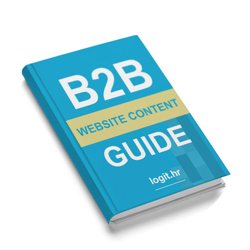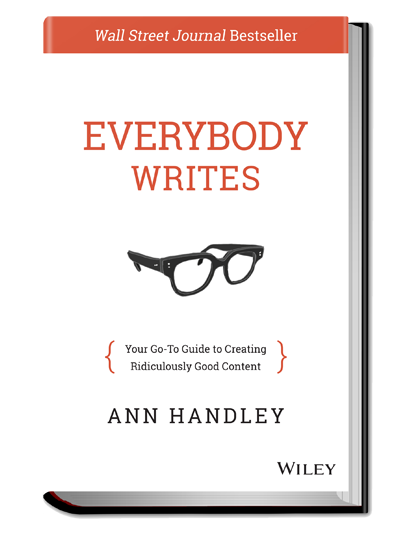This would be a good first book to read on the subject of writing for business. The book has got the right mix of writing advice, grammar tips, links to tools, and inspiration. Probably the book that inspired me to create my writing credo I call “Data, Proof, Examples” for writing persuasive, human-centered content.
What My Book Reading Notes Are About
I’m a compulsive note taker. I can’t read a non-fiction book without taking notes - that’s why it takes me so long to finish a book. Inspired by Derek Sivers’ Book Notes project, I decided to put my compulsion to good use, and publish my notes. The order of the notes more or less follows the order in the book. My notes are a mix of book content pieces and my own thoughts I jot down while I read the book. Buy the book if you like my notes - you learn the most by reading the original.
Book Parameters
- Title: EVERYBODY WRITES: Your Go-To Guide to Creating Ridiculously Good Content / Book Website / Goodreads profile
- Author: Ann Handley
- I read the book in: 2015
Book Reading Notes
Writing Process
- Have a business goal / purpose / objective and align your writing around it.
- Care about the topic you’re writing about.
- What am I trying to achieve?
- Which information am I trying to communicate?
- Why should the audience care?
- Reframe the idea to relate it to your readers. Why should they care? What’s in it for them? What value do I offer to them? What is the gift that I’m giving them? How do I best serve them?
- To answer those questions well, ask yourself “So what” until you exhaust the answers.
- Express those reframed ideas in the FIRST paragraph of the article and let this paragraph be your guidance.
- Seek out the data and examples to confirm your claims.
- credible sources which support my claim?
- research that quantifies the problem?
- real-life stories?
- relevant anecdotes?
- timely developments?
- my own experience - use yourself as a source, what do I know about this story?
- interview people who have gone through that experience and want to talk about it?
- Organize.
- What structure will best support my content, is it a story, a how-to guide? Use what makes the most sense.
- Write to one person.
- Imagine one person who you want to help with this story, and write to him/her. Use you, not they / people.
- Produce The Ugly First Draft (TUFD).
- show up and throw up on the paper, don’t worry about grammar.
- For a perfectionist, this is probably the best lesson, and the ideal thing to practice on.
- Walk Away.
- take a break between the first and the second draft.
- Rewrite.
- Give it a great headline / title.
- Have someone edit it.
- Optimize for readability.
- easy to scan?
- subheadings and bolds?
- tweetable quotes?
- broken walls of text?
- Make a CTA (a call to action) and publish.
“Think Before Ink”
When you struggle, it’s because the idea is not thought through well yet!
- think more about that idea to reach the key point that seems elusive
- jot down some thoughts first (this will help me focus on a point and find support of it)
I can find my key point by asking three questions:
- WHY am I writing this? What’s my objective?
- What is my personal point of view on this? What do I think of this?
- The “So what” exercise: Why does it matter to my audience?
If I can describe the key point in one sentence, it’s a good key point!
Sometimes the key point becomes the headline.
Organizing My Writing
Have a framework that works for me. Any framework - but ONE framework.
“There’s no single way to organize a piece of writing. What works for me (as I said previously) is a single line at the top of the page that sums up the main point I’m trying to make. Then I list some key points that relate to or support my bigger idea. Then I go back and expand on those ideas in another sentence or two, creating paragraphs. Then I move the paragraphs around, adding transitions between them to create a smooth flow.”
So, to repeat - ASSEMBLE your content piece:
- Have a guiding idea that is reader-centric. Put it at the top of the article, or - better yet - write it down on a post-it and put it somewhere where it would focus my writing.
- Have a unordered list of key points that support that idea.
- Go and research those key points, add more meat to my idea, find data and examples and other people’s stories, expand on your ideas.
- Reorganize paragraphs. This is akin to making the unordered lists ordered.
- Make nice transitions between the reorganized paragraphs.
Types of Articles Great for Social Media Sharing
- quiz: “test your privacy knowledge”
- skeptic: “You don’t control your privacy anymore”
- explainer: “The only privacy debate in plain english”
- case study: “how one person got control over privacy”
- contrarian: “why online privacy debate is overblown”
- how to: “five steps to improving online privacy”
- quick how-to: “three simple things you can do in the next five minutes for privacy”
- how not to: “this is how you compromise your privacy”
- first person: “my personal privacy horror story”
- comparison: “how privacy protection services measure up”
- Q&A: “five common questions about privacy, answered by Ed Snowden”
- data: “Are privacy problems increasing? Yes, says survey”
- man on the street: “experts offer opinions on the state of privacy”
- outrageous: “Online privacy is an oxymoron”
- insider secrets: “the top-most expert on privacy shares his privacy settings”
- literary treatment: haiku, poem, cartoon…
On Editing
No, people who we call “good writers” are not the ones who know how to write an excellent first draft. Good writers are people who are excellent editors of their own work.
Macro-editing (the chainsaw editing) (I just love this concept!)
Ask myself these questions:
- Get to the point immediately. Is the section’s / paragraph’s / sentence’ key point stated at the very beginning of each? Move the key point to the front. Remove introductions.
- Slash extraneous stuff - anything that does not support my key point. (But don’t forever delete the good stuff: I could publish the rejected content as a standalone tweet / social media post. Just because an idea needs to be slashed here, it does not mean it’s totally useless.)
- Does every new paragraph / sentence say something new that the previous ones don’t? If not, cut them. (When I edit content written by less experienced writers, this is the most frequent mistake.)
- Delete the first and the last paragraph. They can usually be deleted without losing any meaning.
What It Means to Be Reader-Centric
It means anticipating the readers’ questions and answering them.
It helps to have empathy (or better yet - compassion) for the reader, their situation, their concerns.
Ask yourself these questions in every sentence:
- What am I trying to say?
- What words will express it best?
- What fresh image will make my point clearer?
- Can I put it more shortly?
- Have I said anything that is avoidably ugly?
Have Empathy
At the root of all content there is empathy for the customer experience.
Our readers have:
- needs
- goals
- situations
- questions
- problems
Empathy is the ability to understand the other person’s point of view.
Empathy in content is the ability to solve one person’s problems.
My content needs to meet people where they are at this moment. Understanding needs is crucial - that’s why buyer personas are so important!
The only way to develop empathy for people is to meet them, to talk to them. Go meet them in their habitat, take a peek from their perspective, within their context.
Lede and Kicker
Lede (the opening paragraph): make it as strong as possible.
Kicker (the last sentence): finish strong, with style.
Storytelling
Don’t tell me who you are. Tell me why you matter to me.
Interviewing Tips
- Be an advocate for your audience. What are you trying to get out of the interview for the benefit of your audience?
- Don’t worry about being an ignoramus. I said as much earlier: ask for clarification about what you don’t know. If you’re dealing with a highly technical or intricate issue, it helps to ask, “How would you explain it to your mom or dad?” or “Could you give me an example of how this might play out with a customer?”
- Let the experts talk technobabble for a while. Experts who have had corporate PR training sometimes rely too much on Frankenspeak or canned, prepared responses. In those situations, I find it’s best to just let them get it out of their systems — and then ask follow-up questions to elicit less practiced responses.
- Converse, don’t interview. The best podcast hosts converse with their guests instead of interviewing them. They start out with a planned question or two and then let the response dictate the conversation. “Be prepared, but don’t read off a script”
- Shut up already. Your job is to draw the interviewee out, so try to speak less and let the other person speak more. Try not to interrupt unless it’s to ask a clarifying question. “An interview show isn’t about the host, it’s about the guests”
Citations
Cite as you write. It’s surprisingly easy to forget what content was your own original work and what you sourced, if you let too many hours creep in between the writing and the citing.
Struggling With Writing Website Content?
Be done FAST and EASY with my B2B Website Content Writing Guide.
 Download a FREE Sample
Download a FREE Sample
